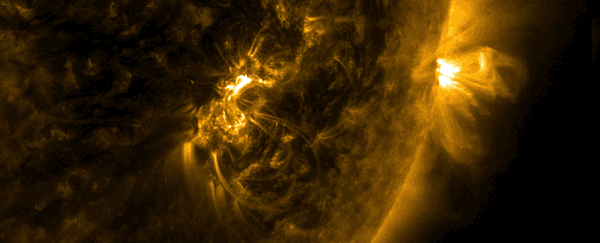Every 11 years, the Sun cycles through from riotous flare and sunspot activity to a quieter period, before ramping up again. It's almost as regular as clockwork, and for years astronomers have been wondering what causes it. Now, they've proposed a new solution.
Even though the Solar System's planets are much smaller than the Sun, the gravity of some of them is able to influence our star's magnetic field. This, the researchers assert, is what controls the solar cycle.
Venus, Earth, and Jupiter assert a small gravitational tug on the Sun as they orbit it. The result is comparable to the way the Moon's gravity influences Earth's tides, producing a regularly timed ebb and flow.
The team has traced back 1,000 years of solar cycles, between the years 1000 and 2009 CE, comparing that data against the movements of the planets in that time. They found an impressively strong link between the two.
"There is an astonishingly high level of concordance: what we see is complete parallelism with the planets over the course of 90 cycles," said physicist Frank Stefani of the Helmholtz-Zentrum Dresden-Rossendorf in Germany.
"Everything points to a clocked process."
What the team found is that the tidal forces are strongest when Earth, Venus, and Jupiter align, and that this alignment occurs every 11.07 years - falling at the same time as the solar minimum.
The effect is a weak one, unable to affect the Sun's interior. This, potentially, could be why no one has previously connected the dots between the solar cycle and the periodicity of the planetary alignment.
But the team has found that despite being weak, the tidal forces can still affect the Sun's magnetic field; in particular, they can influence oscillations in something called the Tayler instability. Such instabilities appear in toroidal (or doughnut-shaped) magnetic fields, where pressure is applied perpendicular to the field's direction.
This causes the field to become compressed, like a spinal column, creating instabilities a bit like slipped discs. These 'slipped discs' in the magnetic field are the Tayler instabilities, and they create perturbations in the solar flux and magnetic field.
Even a small amount of energy - such as, say, from a tidal event - can reverse the oscillations of these perturbations. And if those tidal events were occurring, for example, every 11 years or so, they could trigger a cyclic reversal in the polarity of the magnetic field, resulting in regular fluctuations in activity that corresponds to the cycle.
"When we discovered the current-driven Tayler instability undergoing helicity oscillations in our computer simulations," Stefani said, "I asked myself: What would happen if the plasma was impacted on by a small, tidal-like perturbation?
"The result was phenomenal. The oscillation was really excited and became synchronised with the timing of the external perturbation."
Pretty neat, huh?
And this model could help explain some other mysteries about the Sun. For example, most solar cycles have double peaks at their maximum, with a brief lull in between; this appeared in the simulation.
Other regions to be explored are the way the tidal forces potentially affect the plasma layers in the tachocline, at the base of the convection zone, so that the magnetic flux is conducted more easily.
It could also help us to understand the giant, magnetised Rossby waves that have only recently been discovered rippling across the Sun - and may have something to do with flare activity.
In turn, this could help us better predict out Sun's giant, violent outbursts: a good thing, considering they have the potential to affect our life here on Earth.
The research has been published in Solar Physics.
